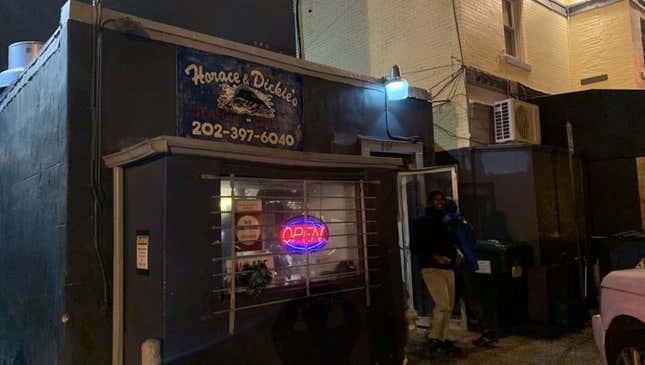
I am getting older. My memory is getting worse. I drive down streets that I don’t know anymore. The child I used to be is long gone and so are the places that held those memories. The touchstones of my life are getting harder to remember. I feel like at times I’m making up a city that I don’t know, like an imaginary homeland, a long-forgotten utopia where black people once lived. I feel like an old man who grew up in Wakanda lying to his offspring about how unified we used to be.
I see the homes I can’t afford and condos being built and I can’t remember what was there before. Was anything there before? Does it matter? Is white settlement what brings life valuation? Didn’t black people ride bikes? Didn’t they deserve bike lanes? Is safety only a concern for white settlers?
The famed black-owned restaurant Horace & Dickie’s is closing in March. Between Ben’s Chili Bowl, Horace & Dickie’s and the Florida Ave. Grill, these historic black landmarks of Washington’s culinary history are responsible for feeding some 98.9 percent of the Washington, D.C., residents who were born here. And now, like losing a limb, Horace & Dickie’s is closing, caught up in the tidal wave of gentrification that only destroys, leaves gaping wounds that never heal and never become whole again.
Or, gentrification remains undefeated.
For 30 years, Horace & Dickie’s served up loaded fish sandwiches for pennies. Seriously, when I was in high school, after my friends and I spent all our money on important stuff like weed and weed, we’d scrape up enough coins to get one sandwich with two extra slices of bread because they put so much fish on the sandwich that two to three people could eat comfortably. This was back when H Street was a shithole. This was back before the streetcar that now carries white residents from Whole Foods to their overpriced condos, which allows them to look over the rest of the neighborhood like a ghetto safari. This was back when you could go into a store with no money and have a conversation that could get you fed because the people working there not only looked like you but they knew your dad and knew he was good for it.
This is the unsettling part of gentrification: It’s not the bombardment of white settling; it’s the lifting of memories and the restructuring of those who came before them. It’s the police who won’t stop ticketing those who double park in front of the 12th Street N.E. hole-in-the-wall spot because white neighbors don’t want them there. So they complain about the traffic, the people running in out of the fish spot, those who are parking in the residential parking spots. This is how gentrification works. First, they land on inhabited land and then they hate the inhabitants. Slowly, they remove what brings the inhabitants and then, like an organic cancer that won’t stop spreading, everything becomes holistic and sterile until nothing remains.
Just two years ago, the Washington Post credited Horace & Dickie’s “with serving one of 24 dishes that shaped how D.C. eats.
“While trendier restaurants adopt chicken and waffles and kale, whiting remains the domain of establishments owned and frequented by African Americans—it’s an old D.C. staple amid so much newness.”
That newness that the Post was talking about was the swell of gentrification that slowly ate those establishments up. And sure, they raised the prices to accommodate those white folks who wanted to eat a history they hadn’t already physically overtaken. And yes, there is a satellite location of Horace & Dickie’s way uptown, but this location was the first and it’s closing.
Owner Richard “Dickie” Shannon told WJLA reporter Sam Ford that he’s tired and ready to play golf. He added that his landlord wanted the property back, surely because he sees gold in “dem dere hills.” Shannon called gentrification “cultural genocide” and noticed that after 30 years of serving a clientele of low-income residents who surrounded his shop, white settlers no longer needed cheaply-priced fried fish.
They’ve got Whole Foods and places that bastardize kale.
And this might be the most fatal blow of gentrification; it’s not the bulldozing of people from land where they once lived or even the bulldozing of places they once shopped; it’s rendering their wants and, by default, themselves inconsequential, as if they never existed. I just hope that when my son and daughter are old enough to hear stories of what the city used to be, I’m still lucid enough to tap into memories that aren’t encrusted with the remains of bitterness to point out the original home of Horace & Dickie’s, to talk about how me, Hayden and Gerone used to split fish sandwiches, back when we didn’t even have enough money to get home.

